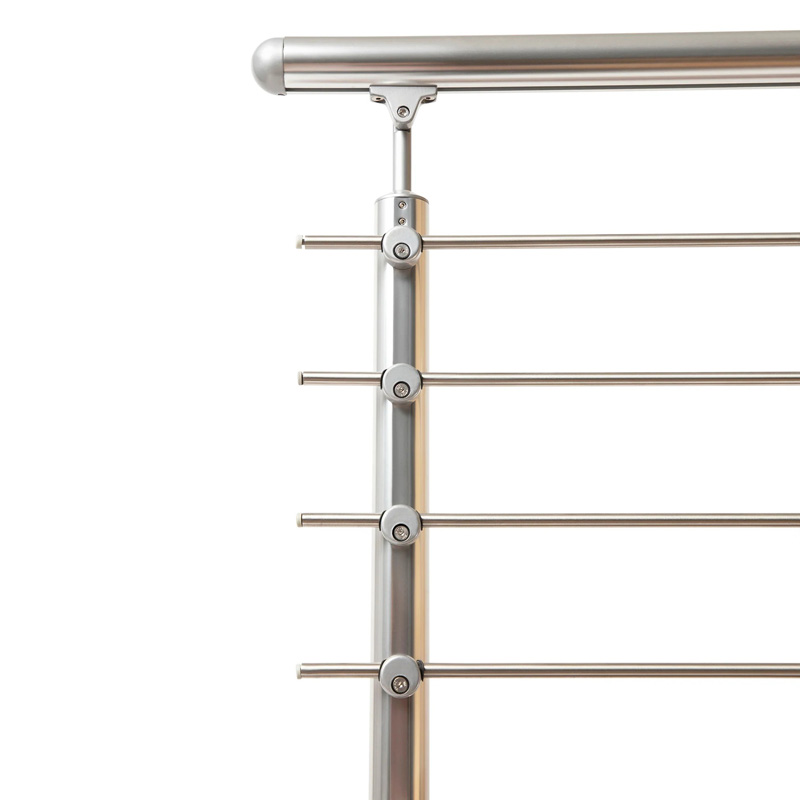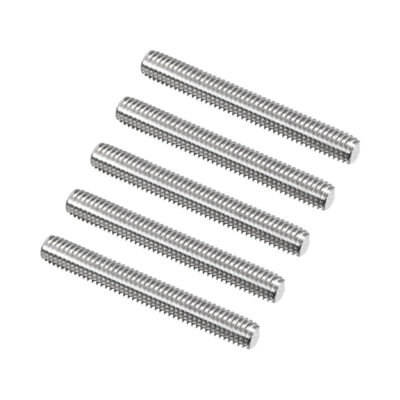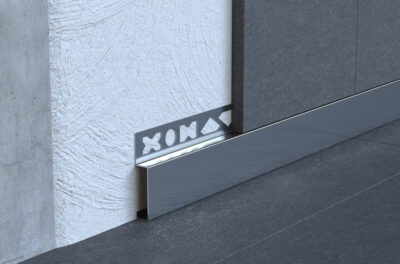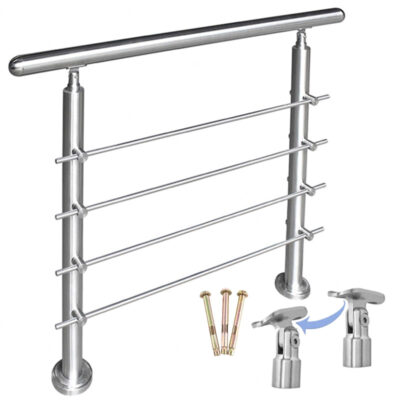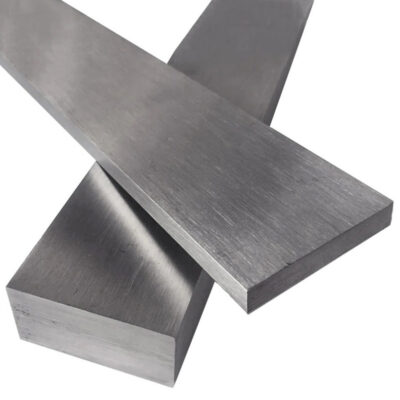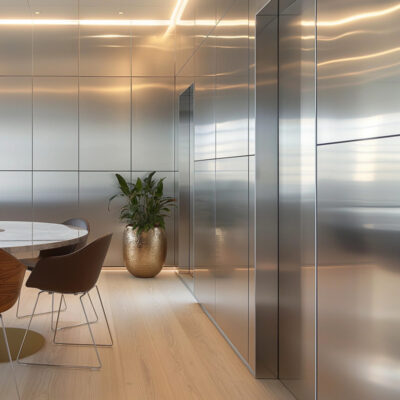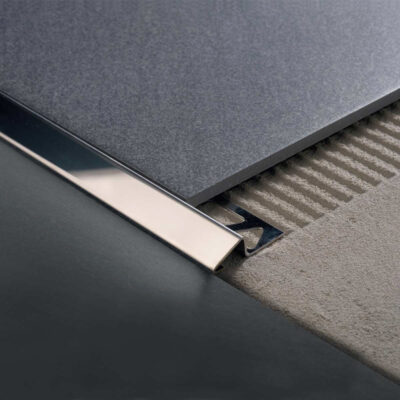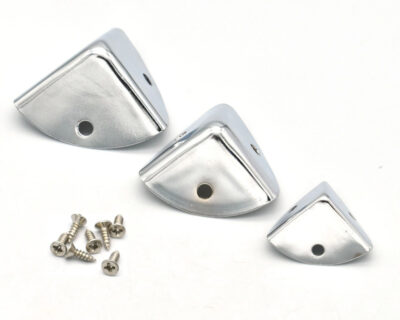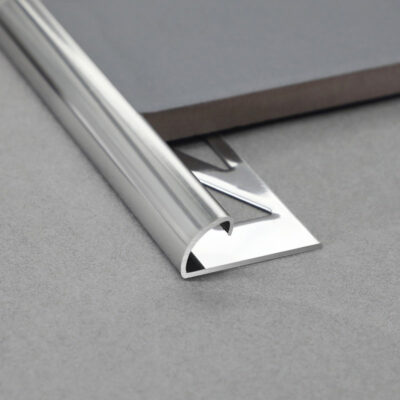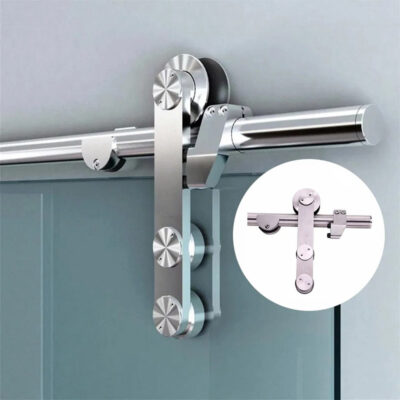The Evolution of Stainless Steel Rod Railings in Modern Architecture
Standing at the edge of a sleek rooftop deck in downtown Seattle last year, I was struck by how the stainless steel rod railing seemed to disappear against the skyline while simultaneously defining the space. That moment crystallized for me why these elegant architectural elements have become increasingly prominent in contemporary design.
Stainless steel rod railing assemblies weren’t always the sophisticated systems we see today. Their journey began in industrial applications, where function trumped form. Early iterations emerged in the mid-20th century, primarily in commercial and industrial settings where durability was paramount. The transition to residential and high-end architectural applications gained momentum in the 1980s and 1990s as minimalist design aesthetics took hold.
What’s fascinating about these railings is how they’ve evolved from purely utilitarian structures to design statements that architects and designers use to establish a space’s character. The clean lines and visual transparency create what designers call “preserved sightlines”—an important concept in spaces where views are a premium asset.
Materials science advancements have played a crucial role in this evolution. Modern 316-grade stainless steel offers superior corrosion resistance compared to earlier alloys, making these systems viable even in harsh coastal environments. This technical improvement has expanded design possibilities dramatically, allowing architects to specify these railings in previously unsuitable locations.
The design language has shifted too. Early systems featured bulky components and visible fasteners, while contemporary assemblies boast nearly invisible connections and structurally engineered minimalism. This shift reflects broader architectural trends toward visual lightness and material honesty.
E-Sang and similar forward-thinking manufacturers have been instrumental in this evolution, pushing the boundaries of what’s possible with innovative connection systems and component designs that maintain structural integrity while reducing visual mass.
Key Components and Assembly Technology of Stainless Steel Rod Railings
The apparent simplicity of stainless steel rod railing assemblies belies their sophisticated engineering. Having dismantled and rebuilt several systems during renovation projects, I’ve gained intimate knowledge of their component architecture.
At their core, these assemblies typically consist of four critical elements:
Vertical posts (sometimes called balasters): These provide the primary structural support and typically anchor to the floor, fascia, or stair stringers.
Horizontal or angled rods: These slender cylindrical elements serve as the infill between posts and are the system’s most visible component.
Connection hardware: This includes specialized fittings, threaded terminals, and tensioners that join the components together.
Mounting brackets and anchors: These critical components secure the entire assembly to the building structure.
The rods themselves typically range from 3/16″ to 1/2″ in diameter, with 1/4″ and 3/8″ being the most common for residential applications. Commercial installations often utilize larger diameters to accommodate increased load requirements and longer spans between supports.
The material composition deserves special attention. While “stainless steel” sounds monolithic, significant differences exist between grades. The most common specifications include:
| Grade | Composition | Best Applications | Corrosion Resistance |
|---|---|---|---|
| 304 | 18% chromium, 8% nickel | Interior installations, mild exterior environments | Good – Resists most household chemicals and mild atmospheric conditions |
| 316 | 16% chromium, 10% nickel, 2% molybdenum | Coastal environments, pools, industrial areas | Excellent – Superior resistance to chlorides, salt exposure, and industrial pollutants |
| 2205 | 22% chromium, 5% nickel, 3% molybdenum | Extreme environments, commercial marine applications | Superior – Highest resistance to stress corrosion cracking and pitting |
Assembly methods have evolved significantly. Early systems relied heavily on welding, which created strong connections but visible joining marks. Modern assemblies often utilize threaded connections with internal tensioners that create clean, seamless appearances while allowing for field adjustments and easier installation.
One particularly innovative development is the introduction of “dry glazing” techniques borrowed from glass railing systems. These allow rods to be secured and tensioned without specialized tools, representing a significant advancement in installation efficiency.
The tensioning process itself requires precision. Under-tensioned rods may rattle or appear slack, while over-tensioning can stress components and potentially lead to failures at connection points. This is why professional installation often yields superior results—achieving that perfect balance between tension and long-term structural integrity requires experience.
Design Versatility and Aesthetic Applications
When I consulted on the renovation of a century-old industrial building in Chicago’s West Loop, the client initially dismissed stainless steel rod railings as “too modern” for the space. After showing examples of how these systems could complement the existing brick and timber elements, they changed their perspective entirely. This highlights one of the most compelling aspects of rod railing assemblies: their chameleon-like adaptability to diverse architectural contexts.
The design versatility of these systems stems from several factors. First, the orientation of the rods themselves can dramatically alter the visual impact. Horizontal arrangements create a linear, contemporary feel that emphasizes width, while vertical orientations reference classical balustrade traditions. Angled or custom patterns can produce distinctive visual rhythms that become signature elements within a space.
Rod spacing also significantly influences aesthetics. Tighter groupings create more visual mass and privacy, while wider spacing maximizes transparency and preserves views. This flexibility allows architects to fine-tune the balance between openness and definition.
The contextual adaptability of these railings continues to surprise me. They work remarkably well in:
Historical renovations: When detailed appropriately, they provide required safety elements while visually receding, allowing original architectural features to remain prominent.
Ultra-modern minimalist spaces: Their clean lines and reduced visual mass complement contemporary design languages.
Transitional environments: They can bridge traditional and modern elements, creating cohesive design narratives.
Indoor-outdoor transitions: The material consistency can flow from interior to exterior spaces, creating visual continuity.
The finish options further extend design possibilities. While polished stainless offers that signature reflective quality that captures and plays with light, satin and brushed finishes provide a more subdued aesthetic with reduced glare. For truly distinctive applications, blackened stainless or PVD-coated options create dramatic visual statements while maintaining material performance.
Regional architectural styles also inform application. I’ve noticed that West Coast designs often emphasize horizontal orientations that frame ocean or mountain views, while East Coast applications frequently feature more traditional vertical patterns that complement colonial and federalist architectural influences.
Technical Advantages: Durability, Maintenance, and Safety
During a recent site inspection of a ten-year-old installation on a waterfront property in Florida, I was struck by how the stainless steel rod railing looked virtually identical to the day it was installed. This exceptional durability represents one of the system’s most compelling technical advantages.
The corrosion resistance of properly specified stainless steel is remarkable. Unlike ferrous metals that oxidize progressively, stainless steel forms a self-healing chromium oxide layer that continuously protects the underlying material. This passive film reforms immediately when scratched or damaged, providing ongoing protection without additional treatments.
This inherent corrosion resistance translates directly to maintenance requirements—or more accurately, the lack thereof. While powder-coated aluminum or steel systems typically require recoating every 5-7 years, and wood railings demand annual refinishing, properly specified stainless assemblies need only occasional cleaning to maintain their appearance and structural integrity.
The maintenance protocol is straightforward:
| Environment | Cleaning Frequency | Recommended Method | Notes |
|---|---|---|---|
| Indoor/Protected | 2-3 times annually | Mild soap, water, soft cloth | Fingerprints and dust are primary concerns |
| Suburban Exterior | Quarterly | Mild detergent, water rinse | Pay special attention to horizontal surfaces where particulates collect |
| Coastal/Industrial | Monthly | Specialized stainless cleaner, thorough rinse | Salt deposits and industrial contaminants require prompt removal |
| Pool Areas | After chemical treatments | Fresh water rinse, mild cleaner | Chlorine compounds can affect surface appearance if not promptly removed |
Structural performance is another significant advantage. The tensile strength of stainless steel rods provides exceptional load resistance with minimal material mass. A properly engineered system significantly exceeds safety requirements while maintaining visual lightness.
Building code compliance merits careful consideration. Most jurisdictions follow International Building Code (IBC) standards, which specify:
- 42″ minimum height for commercial applications
- 36″ minimum height for residential applications
- 4″ maximum sphere passage requirement for residential settings
- Specific load resistance requirements (typically 200 lbs concentrated load)
Safety considerations extend beyond code compliance. The smooth surfaces of rod systems eliminate splinter hazards associated with wood. Unlike glass panels that can shatter, or cable systems that may present entanglement risks for small children, rod systems offer a balance of transparency and security that works well in family environments.
An often-overlooked advantage is the fire resistance inherent to stainless steel. Unlike vinyl, composite, or wooden systems that contribute to fire loads, stainless components remain stable at high temperatures and don’t emit toxic gases when exposed to flame.
Installation Best Practices and Common Challenges
I still remember overseeing a particularly challenging rod railing installation on a curved staircase with variable angles. What seemed straightforward in the architectural renderings became a precision exercise that tested even experienced installers. That project taught me valuable lessons about the critical nature of proper installation techniques.
Successful installation begins with accurate measurement. Unlike some building elements where field adjustments are easily made, stainless rod systems require precise dimensions, especially when posts are positioned at irregular intervals or on curved surfaces. The old carpenter’s adage—measure twice, cut once—becomes particularly relevant here.
Pre-installation planning should address several key considerations:
Substrate evaluation: The mounting surface must provide adequate structural support for the anticipated loads. Concrete typically offers the most straightforward anchoring, while wood and metal substrates may require reinforcement or specialized fastening systems.
Post placement and spacing: This affects both aesthetics and structural integrity. Exceeding manufacturer-recommended spans can compromise load capacity.
Rod tension sequencing: The order in which rods are tensioned can affect the overall system alignment. Generally, working from the center outward produces the most consistent results.
Tool requirements: Specialized tensioning tools are often required. Attempting installation with inappropriate tools can damage components and compromise system integrity.
The most common installation challenges I’ve encountered include:
Uneven surfaces: When mounting posts to irregular substrates, shims or custom base plates may be required to achieve proper alignment.
Corner transitions: The geometry of corners requires careful planning to maintain consistent rod spacing and tension throughout the transition.
Termination details: The beginning and end points of a railing run deserve special attention to ensure clean, finished appearances and proper structural anchoring.
Differential thermal expansion: In systems spanning interior and exterior environments, allowances must be made for the different expansion rates when temperatures vary significantly.
For DIY enthusiasts, I recommend careful evaluation of your skill level before attempting installation. While straight runs with standard components can be manageable for experienced home improvers, complex configurations with angles, curves, or stairs typically warrant professional installation. The difference in results is often immediately visible—professional installations display consistent tensions, precise alignments, and clean terminations that enhance the system’s elegant aesthetic.
Post-installation adjustment is another critical consideration. Most quality systems include mechanisms for future tensioning as components naturally settle over time. Understanding how to properly utilize these adjustment features can extend system lifespan and maintain optimal appearance.
Sustainability and Environmental Considerations
During a panel discussion on sustainable building materials at last year’s International Architectural Symposium, the conversation turned to lifecycle assessments of various railing systems. What surprised many attendees was the favorable environmental profile of stainless steel rod railings when evaluated across their entire lifecycle.
The sustainability story begins with material composition. Stainless steel typically contains 60-80% recycled content, significantly higher than many competing materials. This recycled content reduces virgin material extraction and the associated environmental impacts of mining and processing.
The production process does represent the most energy-intensive phase of the lifecycle. Stainless steel manufacturing requires substantial energy inputs, resulting in higher embodied energy than some alternative materials. However, this initial energy investment must be considered alongside the exceptional lifespan of the finished product.
Life-cycle analysis reveals the environmental advantages:
| Lifecycle Phase | Environmental Considerations | Comparison to Alternatives |
|---|---|---|
| Raw Material | High recycled content (60-80%) | Superior to aluminum (typically 30-35% recycled) and PVC (minimal recycled content) |
| Manufacturing | Energy-intensive production | Higher embodied energy than wood, lower than aluminum when recycled content is high |
| Transportation | Dense material with higher shipping weight | Less volume than assembled alternatives, allowing efficient shipping |
| Use Phase | Minimal maintenance, no chemical treatments | Superior to wood (requires stains/sealers) and painted metals (require recoating) |
| End of Life | 100% recyclable with established recycling streams | Superior to composites and treated woods that often end in landfills |
The durability factor cannot be overstated. While a typical wood railing might require replacement every 15-20 years (with treated lumber entering landfills), a properly specified stainless system can remain in service for 50+ years. This extended service life amortizes the initial environmental impact across decades rather than years.
Beyond material considerations, the design characteristics themselves contribute to sustainability objectives. The transparent nature of rod railings allows light penetration, potentially reducing artificial lighting requirements in interior applications. In exterior settings, the same transparency permits airflow, which can contribute to passive cooling strategies.
Some manufacturers have embraced additional sustainability practices, including:
- Water recycling in manufacturing processes
- Solar-powered production facilities
- Zero-waste packaging initiatives
- Regional manufacturing to reduce transportation impacts
When specifying these systems for projects targeting LEED or other green building certifications, the recycled content and regional manufacturing aspects can contribute to material and resource credits. The lack of VOCs or chemical treatments also positively impacts indoor environmental quality considerations.
The complete recyclability at end-of-life creates true circularity. The stainless steel components can be recycled infinitely without degradation of material properties, unlike many alternative materials that can only be downcycled into progressively lower-value applications.
Cost Analysis and Return on Investment
When evaluating the cost proposition of stainless steel rod railing assemblies, I’ve learned to guide clients beyond the initial price tag to a more comprehensive understanding of lifetime value. This broader perspective often changes the conversation entirely.
The upfront investment is undeniably higher than some alternatives. Based on current market conditions, here’s how the initial costs typically compare:
| Railing System | Approximate Cost Range (Materials Only) | Average Installation Cost | Typical Total Installed Cost |
|---|---|---|---|
| Stainless Steel Rod | $150-$350 per linear foot | $60-$100 per linear foot | $210-$450 per linear foot |
| Aluminum | $90-$200 per linear foot | $50-$80 per linear foot | $140-$280 per linear foot |
| Wood (Cedar/Redwood) | $70-$150 per linear foot | $40-$70 per linear foot | $110-$220 per linear foot |
| Glass Panel | $180-$400 per linear foot | $70-$120 per linear foot | $250-$520 per linear foot |
| Cable Railing | $140-$300 per linear foot | $50-$90 per linear foot | $190-$390 per linear foot |
These figures fluctuate based on specific design requirements, regional labor costs, and material grade selections. The range for stainless systems reflects significant variation between basic assemblies and custom-designed premium products.
Where the value proposition becomes compelling is in the long-term cost analysis. When maintenance and replacement costs are factored in over a 30-year period, the lifetime cost equation changes dramatically:
For a typical 60-foot residential deck railing:
Pressure-treated wood may require complete replacement 2-3 times, plus annual maintenance, resulting in lifetime costs often exceeding twice the initial investment.
Painted aluminum systems typically need recoating every 5-7 years, with potential corrosion issues in coastal environments requiring component replacement.
Stainless systems require only minimal cleaning maintenance, with potential tensioning adjustments representing the only significant service need.
The return on investment manifests in several ways beyond direct cost savings:
Property value enhancement: Real estate professionals consistently identify quality railing systems as high-value upgrades that positively affect property valuation and marketability.
Reduced opportunity costs: The time and disruption associated with refinishing or replacing inferior railing systems represent real but often uncalculated costs.
Aesthetic longevity: While design trends evolve, the clean, timeless appearance of well-designed stainless systems tends to remain relevant across changing style preferences.
Another economic consideration is the potential for modular reuse. I’ve worked with clients who relocated quality stainless systems from previous homes to new properties, a practical option rarely viable with site-built wood or permanently installed alternatives.
For commercial applications, the durability advantage translates directly to reduced facility maintenance budgets and extended renovation cycles. This predictability allows for more accurate long-term capital planning.
When discussing budget constraints with clients, I often recommend a hybrid approach—using premium stainless systems in high-visibility or high-exposure areas while employing more economical solutions in secondary locations. This strategic application maximizes the aesthetic and property value benefits while respecting budget realities.
Future Innovations and Emerging Trends
During my visit to the International Building Products Expo in Frankfurt last fall, I noticed a clear shift in how manufacturers are approaching stainless steel rod railing systems. These innovations point to exciting developments that will likely reshape the category over the next decade.
Perhaps the most significant emerging trend is the integration of digital fabrication technologies. Advanced manufacturers are now employing parametric design tools that allow for complex geometries and custom configurations without prohibitive cost premiums. This computational approach to design and fabrication is enabling organic forms and variable spacing patterns that were previously impractical.
Material science continues to advance as well. New developments I’ve been tracking include:
Super-duplex alloys: These provide even greater corrosion resistance and strength, potentially allowing for smaller diameter rods without sacrificing structural integrity.
Surface treatment innovations: New finishing technologies are creating micro-textured surfaces that reduce fingerprinting and maintain appearance with less maintenance.
Composite rod technologies: Carbon fiber cores with stainless sheaths offer intriguing possibilities for increased span capabilities while maintaining slender profiles.
PVD color technology: Physical Vapor Deposition techniques are enabling consistent, durable color options beyond traditional silver tones, without the environmental issues associated with traditional plating.
The intersection with smart home technology represents another frontier. Early applications include:
- Integrated LED lighting systems that transform railings into architectural lighting elements
- Embedded sensors that monitor structural integrity and tension levels
- Heating elements incorporated into outdoor railings for snow and ice management
- Touch-sensitive sections that can activate connected home features
Sustainability innovation continues to advance as well. Several manufacturers are exploring carbon-neutral production facilities and enhanced recycling programs that allow for closed-loop material cycles where old railings are directly recycled into new systems.
One particularly interesting development is the emergence of modular connection systems that enable easier disassembly and reconfiguration. This approach aligns with circular economy principles by facilitating component reuse rather than complete system replacement when design needs change.
From an aesthetic standpoint, I’ve observed increasing experimentation with mixed materials—combining stainless components with wood, glass, or textiles to create visually striking hybrid systems that leverage the structural properties of metal with the warmth or transparency of complementary materials.
The regulatory landscape continues to evolve as well. Upcoming code revisions are likely to address enhanced requirements for childproofing and accessibility that will influence design parameters. Forward-thinking manufacturers are already developing solutions that anticipate these changes.
Installation methodologies are also advancing, with new systems designed specifically to reduce on-site labor requirements and specialized skill needs. Tool-free tensioning mechanisms and pre-fabricated modules that snap together represent significant steps toward making these systems more accessible to a broader range of installers.
As architectural trends continue to emphasize connections between indoor and outdoor spaces, the demand for weather-resistant, visually minimal boundary elements will likely increase. Stainless rod systems are uniquely positioned to meet this need, suggesting continued growth in both residential and commercial applications.
Frequently Asked Questions about Stainless Steel Rod Railing Assemblies
Q: What are Stainless Steel Rod Railing Assemblies?
A: Stainless Steel Rod Railing Assemblies are durable, modern railing systems that use stainless steel rods as infills. These systems are renowned for their strength, corrosion resistance, and sleek aesthetic, making them suitable for both indoor and outdoor environments. They offer a blend of functionality and contemporary design, often used in modern architecture.
Q: What are the benefits of using Stainless Steel Rod Railing Assemblies?
A: The benefits of Stainless Steel Rod Railing Assemblies include:
- Durability and Strength: They are built to last with a material that can withstand harsh conditions.
- Corrosion Resistance: They are resistant to rust and corrosion, especially when made from specific alloys like Duplex Stainless Steel.
- Aesthetic Appeal: They offer a sleek, modern look that fits well with contemporary design styles.
- Easy Maintenance: They require minimal upkeep, typically involving just a routine cleaning.
Q: How do Stainless Steel Rod Railing Assemblies compare to Cable Railings?
A: While both Stainless Steel Rod Railing Assemblies and cable railings offer modern aesthetics, they have distinct differences:
- Installation: Rod railings can be more straightforward to install, with less flex in curved applications.
- Corrosion Resistance: Rod railings may use alloys like Duplex Stainless Steel, which offers superior corrosion resistance compared to some cable railing materials.
- Design Flexibility: Rod railings can fit curved sections more easily than cable railings.
Q: What kinds of environments are Stainless Steel Rod Railing Assemblies suitable for?
A: Stainless Steel Rod Railing Assemblies are suitable for both indoor and outdoor environments. They are particularly beneficial in areas exposed to harsh weather conditions due to their corrosion resistance and durability. This makes them ideal for installations in commercial spaces, residential balconies, or any area requiring a strong, aesthetically pleasing railing system.
Q: Can Stainless Steel Rod Railing Assemblies be customized?
A: Yes, Stainless Steel Rod Railing Assemblies can be customized to fit specific architectural needs. This includes adjusting the spacing and design of the rods, choosing different materials for components like posts and handrails, and integrating with other infill options to create a unique look. Customization allows these assemblies to complement various building styles and design preferences.

